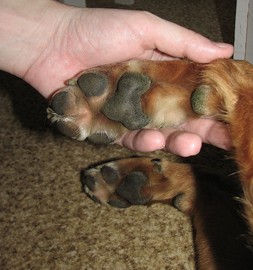As a veterinarian, I often have to examine pets that have rarely had their toes or ears touched, and it isn’t easy. The pets fidget and the pet parents fret. For all concerned, getting your pet used to being touched and examined will make veterinarian visits more enjoyable. You’ll also get early warning signs if anything about your pet is out of kilter. Here are some suggestions:
Touch your pet’s feet. Pets often don’t like to have their paws touched, but we need to get them used to it so their nails can be trimmed and we can examine them for injuries. Regularly massage the toes gently. Look between the pads and at the nails. Feel the joints. This allows you to become very familiar with your pet’s paws so you can recognize any injuries or abnormalities. It also gets them used to having their feet touched in preparation for the dreaded nail trimming that most pets and pet parents abhor. Giving treats during this process will sweeten it.
Check your pet’s ears. Some pets are as sensitive about having their ears touched as they are about their paws. But a conscientious pet parent will look in a pet’s ears regularly to check for growths, redness, any abnormal build up or pain. (Take a whiff as well; smelly ears may indicate a problem.) If your pet dislikes you touching his or her ears, start slowly by massaging the canals and tips without lifting the earflaps and then gently move on to lifting the earflap and looking inside. Many pets encounter ear infections at some point in their lives, so home exams may catch a problem sooner. Some pets may even enjoy getting their ears massaged once they get used to it. Again, I am a big fan of treats throughout this process.
Look in your pet’s mouth. Unfortunately 99% of pets experience dental disease. It’s up to you to forestall problems by examining your pet’s mouth regularly. Start by slowly lifting the lip and taking a look at the teeth and gums. Note if there is a smell or if there are sores or growths or any change in the color of the gums. (Once your pet is used to your exams, tooth brushing will be easier, and I absolutely recommend daily tooth brushing to keep his mouth and teeth as healthy as possible.)
Finally, pet your pet. Massage the skin, rub the head, scratch under the chin (they really love that). This will allow you to note any bumps, sores, parasites like ticks or fleas, changes in fur or areas of pain or sensitivity that may be new. This will be an “exam” he or she won’t resist.

